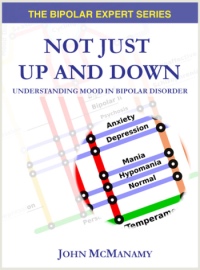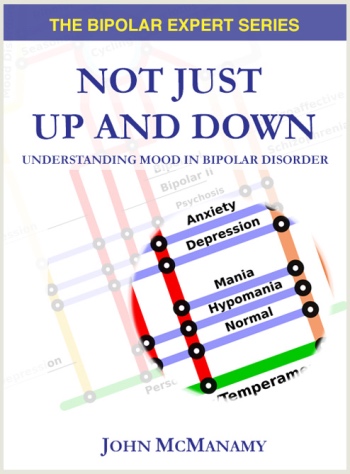What's in Your Diagnosis?
 |
Confused about your illness? So are the experts.
|
Bipolar Disorder Symptoms. What is wrong with the bipolar diagnosis?
The third chapter of Goodwin and Jamison’s 2007 second edition to their landmark "Manic Depressive Illness: Bipolar Disorders and Recurrent Depression," wastes no time getting to the point. The chapter is entitled, "Diagnosis," and the first sentence reads:
The history of psychiatric diagnosis has been notable for the confusion reflected in the myriad overlapping systems for classifying and subdividing depressive disorders.
My New Book!

Purchase now.
A little further along, the authors inform us:
The organization of both DSM-III and DSM-IV implies that bipolar disorder is distinct from all forms of major depression. This division discourages consideration of underlying unifying relationships between bipolar and the more highly recurrent forms of unipolar disorder, including the possibility that they fall along a spectrum.
The authors also contend that this confusion results in patients being misdiagnosed with unipolar depression. The authors further identify other major weaknesses in the DSM, including:
- Emphasis on episode rather than disorder, with no consideration of natural course, longitudinal patterns, and family history.
- Weighting all criteria equally (a la checklist).
- Narrow criteria for mixed episodes (that exclude many dysphoric manias and agitated depression).
- Over-focus on euphoria in mania and hypomania.
- Arbitrary length for manic and hypomanic episodes.
- Lack of satisfactory boundaries for cyclothymia.
- Lack of clarity concerning whether various clinical conditions may be a distinct disorder, two or more co-occurring disorders, or some kind of diagnostic hybrid.
- Problems with differential diagnoses (especially regarding borderline personality disorder and, in kids, ADHD).
- Schizoaffective disorder: Schizophrenia lite, BP heavy, a separate illness, two co-occurring illnesses, or something occupying the psychosis spectrum?
Intriguingly, references to the DSM virtually disappear after the third chapter. It’s as if the authors have decided that psychiatry’s diagnostic bible is irrelevant to clinical reality, let alone to brain science and genetics.
Unfortunately, patients (and their clinicians) are not likely to read Goodwin and Jamison. Far more likely, patients will develop their understanding of their illness from various websites, books, and pamphlets, not to mention quickie explanations from their clinicians, virtually all of it derivative of the DSM. As an article in the Jan 3, 2005 New Yorker explains, in reference to the breakthrough third edition of the DSM in 1980:
Almost immediately, the book started to turn up everywhere. It was translated into thirteen languages. Insurance companies, which expanded their coverage as psychotherapy became more widespread in the nineteen-seventies, welcomed the DSM-III as a standard. But it was more than that: the DSM had become a cultural phenomenon.
In other words, the DSM has set the tone not only for the information we read, but the advice and treatment and therapy we receive or may be denied from receiving. Its surprise runaway success more than a quarter century ago moved psychiatry into a more modern age, but a strong case can now be made that in its present – and essentially unchanged – form it is impeding progress.
Which begs the obvious question: If the DSM leaves so much to be desired, yet remains uncritically accepted by the professionals we entrust our lives to, what does this say for our prospects of recovery?
It also begs this slightly less obvious question: If the DSM is so firmly entrenched in medical, insurance, and other circles, what are our chances that those responsible for the DSM-5 will place our needs above those who make money off our illness? (The answer to that is in a new section to mcmanweb, DSM-5.)
Take the DSM – Please!
First an explanation: The term nosology refers to the systematic classification of illnesses.
Now the good news. At a symposium at the American Psychiatric Association’s Annual meeting in May 2007 entitled, "The Controversy over Lumping vs Splitting in Psychiatric Nosology" (seriously, this word has to go), four speakers demonstrated that at least some psychiatrists are encouraging some serious thinking outside the DSM box.
The bad news is the symposium was sparsely-attended.
Ahmed Okasha MD of Ain Shams University (Cairo) pointed out that psychiatry has no gold standard for identifying disorders. The DSM-IV has parsed out 284 psychiatric disorders. Rare is the patient diagnosed with just one of these disorders. Further diagnostic confusion is evidenced in the lack of treatments specific to a particular diagnosis. For instance, antidepressants are "misnomers," as they treat many other illnesses aside from depression.
G Scott Waterman MD of the University of Vermont argued that the DSM system, with its emphasis on subjective experiences, "separates us from the rest of medicine." Further, the DSM’s tendency to set symptom lists in stone "retards development of understanding."
Juan Lopez-Ibor PhD of Complutense University (Madrid) attacked the DSM’s arbitrary splitting of illnesses by category, pointing out that even the pioneering diagnostician, Emil Kraepelin, expressed second thoughts in his last writings over the dividing line he drew between what he called manic-depression (now bipolar and recurrent depression) and dementia praecox (now schizophrenia).
Hagop Akiskal MD of the University of California, San Diego was his usual reserved and diplomatic self. "The emperor has no clothes," he thundered. Referring to the disconnect between the DSM and what he sees as clinical reality, Dr Akiskal informed his audience that "our patients are violating our nosology every day."
For instance, limbic hyperactivity (ie how our brains react to the environment and life experience) appears to confound diagnostic categories.
Making his case for a spectrum approach that would include a range of disorders and behaviors within the bipolar umbrella, Dr Akiskal argued that "these are the type of patients that I see, and that my residents see."
The DSM - Bad for Your Health?
Criticism of the DSM comes from surprising sources. In a 2002 white paper published by the American Psychiatric Association, entitled, "A Research Agenda for DSM-V," Dennis Charney MD, then chief of the Mood and Anxiety Disorders at the NIMH, and his colleagues wrote:
The descriptive approach adopted by the DSM allowed for the development of a classification system that met the field’s need for a common language, without being mired in ideological hypotheses about the causes of psychiatric illness. Questions have been raised by many critics that the DSM’s descriptive approach may have outlived its usefulness and is in fact potentially misleading.Significantly, the white paper was edited by Michael First MD, David Kupfer MD, and Darrell Regier MD, PhD. Dr First played a prominent role in the DSM-IV. Drs Kupfer and Regier head up the DSM-5.
Dimensional vs Categorical
The dimensional approach recognizes that having "a little bit" of an illness may be clinically significant, and that a decent measure for "severity" would also be useful. The refined calibrations of the dimensional approach have been proposed as an antidote to the DSM’s all-or-nothing categorical system. As described by Oregon psychiatrist Jim Phelps MD in his book, "Why Am I Still Depressed," in the context of the mood spectrum:
Instead of saying ‘yes’ or ‘no’ as to whether you might have a mood disorder, [psychiatrists] try to determine how much bipolarity you have.
On his website, Dr Phelps relates how this approach is used in clinical practice at Harvard’s Bipolar Clinic:
"The system considers five ‘dimensions’ of bipolarity. Note that the presence of hypomania or mania is only one of the five dimensions. All the others receive equal weight …
1. Hypomania or mania
2. Age of onset of first mood symptoms
3. Illness course and other features generally only visible over time
4. Response to medications (antidepressants and mood stabilizers)
5. Family history of mood and substance use problems."
(When discussing polarity, depression is a given.)
One of the authors of this system is S Nassir Ghaemi MD, fnow at Tufts University. Dr Ghaemi has headed up a 30-member Diagnostic Guidelines Task Force of the International Society of Bipolar Disorders, an organization of leading researchers and clinicians. According to the Task Force:
"We expect the impact of this work to be a significant contribution to the ongoing debate and to have some resonance with the DSM-V research group …"
As well as Dr Ghaemi, the committee included outspoken spectrum advocates such Frederick Goodwin MD, Franco Benazzi MD, and Dr Phelps, plus a host of other leading lights who have shaped the conversation. So going with a dimensional system was a foregone conclusion with this committee, right?
Well, uh, not exactly. As Lakshmi Yatham MD of the University of British Columbia and President of the International Society for Bipolar Disorders (ISBD) explained at the Seventh International Conference on Bipolar Disorder held in June:
Rightly or wrongly our committee decided that for the time being it’s perhaps better to stick with the categorical system and … make refinements so that they become much more useful.
Whoa! What happened?
Walk, Do Not Run
Question time at the DSM symposium indicated that it may be prudent to exercise caution. As Nick Craddock MD, PhD of Cardiff University, who has made breakthrough genetic findings demonstrating an overlap between bipolar and schizophrenia, related: "We’re in the pickle we’re in at the moment because we have arrived at things through opinion and expert ideas rather than solid data." In light of the fact that a better biological understanding of what’s going on is years away, "it would be incredibly unfortunate if we set up an edifice of dubious categories."
This thinking is reflected in the Dr Charney’s section of the APA’s 2002 white paper:
Current classification in psychiatry therefore resembles the medicine of 50–100 years ago, before the underlying pathophysiology of many disease processes was understood.
Dr Charney et al write that it will be years, "and possibly decades," before a suitable match between diagnostics and science is possible, and when it occurs it is highly likely that "current symptom clusters of DSM will ultimately not map onto distinct disease states."
In other words, today’s psychiatry may be to tomorrow’s psychiatry what astrology is to astronomy. We may be on the cusp of paradigm-rocking new insights, but we are not there yet. Before we start realigning our diagnostic universe, perhaps it would be advisable first to come to grips with the psychiatric equivalent of gravity.
Final Word
What’s in your diagnosis? You cannot afford to wait until 2013 to find out and neither can your clinician. Be smart. Live well …
Published Feb 10, 2010, updated Jan 5, 2011
 |
More articles on mood. |




